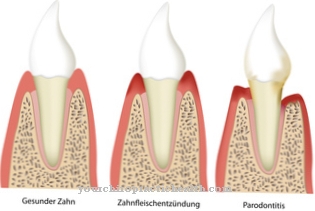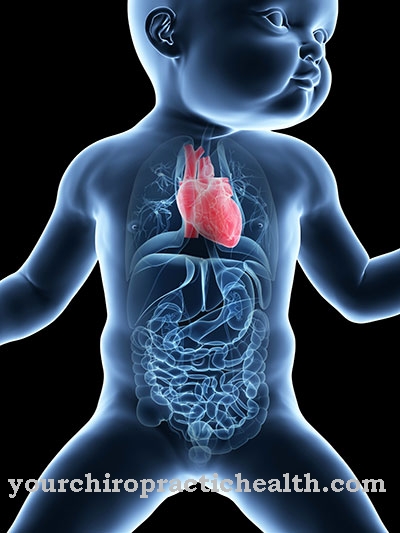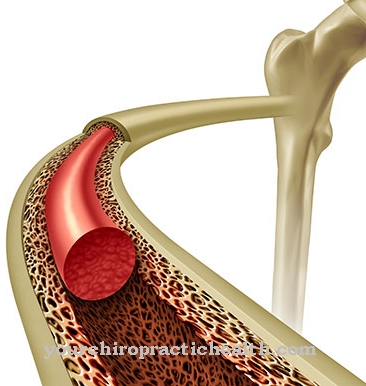The Bartholinitis is a relatively painless enlargement of a gland in the vaginal area. Infection causes inflammatory abscesses, which in most cases are easy to remove.
What is Bartholinitis?

© magemasher - stock.adobe.com
Bartholinitis affects the Bartholin glands on both sides of the entrance to the vagina. They produce fluid on the lining of the (inner) surface of the labia majora to secrete (i.e., moisturize) the vagina.
Sometimes the openings in these glands become blocked, causing fluid to return to the gland. The resulting bartholinitis is a swelling (cyst) the size of a hen's egg in the lower area of the labia.
If infected, an inflammatory abscess forms that needs treatment. Bartholinitis is common, especially among younger women under 30.
causes
Experts believe that the cause of bartholinitis is a build-up of fluid in the glands. Secretion can mainly accumulate when the opening of the gland (duct) is blocked by skin folds or due to infections. These are caused by various bacteria.
Bartholinitis, for example, is caused by intestinal bacteria such as Escherichia coli, which can get into the vaginal area through improper hygiene. An infection with Neisseria gonorrhoeae, bacteria causing gonorrhea or with Chlamydia trachomatis can lead to bartholinitis. Chlamydia infections in particular often go undetected in women because there are hardly any symptoms.
However, the bacteria lodge themselves intracellularly, where they can cause chronic inflammations such as bartholinitis as energy parasites. Due to favorable climatic conditions or a weakened immune system, the bacterium Staphylococcus aureus, which is present in up to 30% of people in the body, can also spread and trigger Bartholinitis.
Symptoms, ailments & signs
Bartholinitis is primarily a painful inflammation in the lower third of the small or large labia. These swellings usually only appear on one side and are very painful (pressure). Those affected feel pain especially when sitting or walking, which can increase in intensity as the disease progresses.
Sometimes the affected area becomes red and itchy. A possible concomitant symptom is a fever, which manifests itself as sweating, fatigue and other characteristic symptoms. Bartholinitis can be recognized by its noticeable appearance. The enlargement of the glands reaches the size of a hen's egg and is usually very red, although this depends on the course and any accompanying illnesses.
If the bartholinitis is treated immediately, the growth remains almost skin-colored and swells less. If an infection develops in the area of the enlarged gland, further symptoms usually arise. This can lead to painful inflammation.
Bartholinitis often becomes wet or bleeds. This is accompanied by throbbing pain, which can radiate to the entire genital area and in severe cases to the abdomen. Based on these symptoms, the disease can be clearly diagnosed.
Diagnosis & course
If the cyst remains small in bartholinitis and no infection occurs, the disease is often not noticed. If it grows further, a small swelling is initially perceived on one side of the vaginal entrance, which is painless.
However, within a few days, bartholinitis can develop into a full-blown infection with a painful lump, making it difficult to walk or sit. Painful intercourse can also indicate bartholinitis.
If the knot does not resolve after two or three days of self-treatment (e.g. Sitz baths) or if severe pain occurs, a doctor should be consulted immediately for treatment of the bartholinitis. In older women over 40, other possible diagnoses (e.g. cancer) should be checked in this context. To diagnose bartholinitis, in addition to a pelvic exam, a smear is taken from the vagina or cervix to test the bartholinitis pathogen.
When should you go to the doctor?
As a rule, bartholinitis leads to relatively severe and unpleasant symptoms in the vagina area and especially on the labia. For this reason, a doctor should be consulted if there is unexpected pain or swelling in this region. The labia may also be reddened or even affected by itching. It is not uncommon for patients to be ashamed of the bartholinitis. Treatment by the doctor is essential.
Painful intercourse can also be a symptom of Bartholinitis and should definitely be examined by a doctor. In most cases, however, Bartholinitis can be treated well reactively. It also causes discomfort or pain while sitting or walking. A doctor must then also be consulted. As a rule, Bartholinitis can be treated directly by the gynecologist. There are no special complications or other complaints and in most cases the course of the disease is completely positive.
Doctors & therapists in your area
Treatment & Therapy
Treatment for bartholinitis depends on the size of the cyst, the pain, and the degree of infection in the cyst. Sometimes treatment can be done at home. To do this, you should take a bath in a tub with a little warm water (hip bath) several times a day for three or four days in order to burst a smaller infected cyst.
In more severe cases of bartholinitis, surgical drainage using local anesthesia or sedation is necessary. For treatment, the doctor makes a small incision on the cyst to drain it and then puts a small rubber tube (catheter) into the incision. This remains in place for up to six weeks in order to keep the glands open until the Bartholinitis has completely healed and to allow complete drainage.
This treatment for bartholinitis is often accompanied by antibiotic medication, especially if the bartholinitis was caused by a sexually transmitted infection.
In the case of frequent cyst formation, a so-called marsupialization is carried out. To do this, small drainage incisions are made on each side of the vaginal entrance to create a permanent opening of around 6 mm each. If these procedures do not help, surgical removal of the Bartholin's gland may be advisable.
Outlook & forecast
Bartholinitis has a very favorable prognosis if the cyst is small and occurs without an inflammatory process. In these cases, medical treatment is usually not required. The painless cyst is often not even noticed by the patient. The larger the cyst, the more likely it is that medical intervention is necessary.
The cyst is usually completely removed within a few minutes in a routine operation. After the wound has healed, the patient is symptom-free and is considered to be healed. The process takes a few days or weeks. Despite recovery, bartholinitis can develop again over the course of a lifetime. Younger women under the age of 30 are particularly affected.
If it occurs again, the prognosis does not change. It is again dependent on the individual circumstances. However, due to her previous experience, the patient is often sensitized to the first symptoms and requires treatment more quickly. This has a positive influence on the healing prospects.
The prognosis is particularly unfavorable if the patient also suffers an infection. This must also be treated with medication. Removal of the cyst is then insufficient. The healing process is delayed and complications can occur with a weakened immune system.
prevention
To prevent bartholinitis, we recommend practicing safer sex using a condom and thorough hygiene of the female genital area to prevent the ingress of intestinal bacteria that cause bartholinitis.
Aftercare
After bartholinitis, the genital area must first be protected from further irritation. By avoiding scented and aggressive care products, the sore area can heal well without reddening with itching and other discomfort. After severe bartholinitis, it is recommended to use Sitz baths or compresses with antiseptic or soothing solutions.
Wound cleansing rinses for use in the intimate area have also proven themselves. Affected women should first visit the gynecologist every one to two weeks and have the necessary check-ups carried out. After a month, you can return to the usual cycle, provided the doctor does not detect any further abscesses or redness.
Further follow-up care will focus on identifying the triggers of bartholinitis. Affected women should first change their bed linen and check shampoos and shower gels for allergens. In addition, strict intimate hygiene should be observed in the weeks and months following an acute Bartholinitis.
Possible triggers such as chlamydia or streptococci can be found in particular in public toilets, which are best avoided. If the inflammation occurs again despite all the measures taken, a visit to the gynecologist is recommended.
You can do that yourself
Bartholinitis rarely heals itself and the disease must be treated by a doctor, especially in an advanced stage. If the disease was caused by gonococci, the causative agent of the sexually transmitted disease gonorrhea (gonorrhea), treatment with antibiotics is indicated. Opportunities for self-help are not available here.
However, sexually active people can prevent infection. Since gonococci are very easily transmitted during sexual intercourse, an infection can only be completely prevented by abstinence. The risk of infection can, however, be reduced significantly through preventive measures. This includes, above all, the consistent use of condoms, which should not only be used for vaginal, but also for anal and oral sex, as well as during foreplay.
An early stage bartholinitis that was not triggered by gonococci can also be treated by those affected. Anti-inflammatory and analgesic ointments from the pharmacy are particularly helpful here. In addition, Sitz baths can alleviate symptoms. Baths with highly concentrated salt water have a strong antibacterial effect and are usually very effective, but if the genital area is already irritated, such baths can be very painful. The salt dose should therefore be increased slowly. Sitz baths with chamomile tea or chamomile tea concentrate are also helpful.
Irradiation with red light can help isolate the focus of inflammation from healthy tissue.



.jpg)























